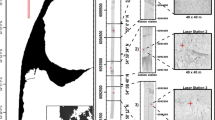Abstract
Morphological variation and vertical distribution of Fucus vesiculosus were quantified at several sites in the Finnish archipelago (Baltic Sea). F. vesiculosus samples were obtained from skerries at geographical distances of 1 km or more (large scale) and at intervals of ca 100 m around a single island (small scale). The results were examined in relation to wave exposure, calculated by Baardseth and effective fetch cartographic methods. Despite the fact that the exposure indices were calculated differently they correlated strongly. Vegetative morphological characteristics of F. vesiculosus illustrate the morphological differences both within and between exposure gradients. The tallest and widest F. vesiculosus plants were found at the sheltered end of the large-scale exposure gradient. Those from equally sheltered sites of the island were smaller in all respects. Thus, the trend from small narrow plants to large wide sheltered plants was expressed differently over the different geographical scales. Consequently localities with similar exposure indices may have morphologically different F. vesiculosus populations. Shores with similar cartographic exposure indices can be different in nature. Underwater topography and shore locations, either close to the mainland or at the outermost sites of the archipelago, affect the exposure. Although a sheltered shore is indicated, the sublittoral zone may be quite exposed to the movements of water. In contrast, in an open shore environment underwater rocks, boulders and shallow water areas can provide sheltered habitats. The depth range of the F. vesiculosus belt exhibited two distinctive patterns. At sheltered sites, around islands in the outermost reaches of the archipelago F. vesiculosus can grow to a maximum depth of 5 m. In exposed habitats the belt becomes narrower, reaching a maximum depth of 3 m. Closer to the mainland F. vesiculosus is found at exposed sites to a maximum depth of 5 m; the depth range at sheltered sites is narrower, only reaching depths of 2 m or less. In conclusion, the changes in plant morphology and in the vertical belt distribution are similar to each other along both gradients at the exposed ends of the wave action spectrum; however, the two gradients diverge at the sheltered ends of the spectrum.
Similar content being viewed by others
Author information
Authors and Affiliations
Additional information
Received: 10 August 1998 / Accepted: 11 January 1999
Rights and permissions
About this article
Cite this article
Ruuskanen, A., Bäck, S. & Reitalu, T. A comparison of two cartographic exposure methods using Fucus vesiculosus as an indicator. Marine Biology 134, 139–145 (1999). https://doi.org/10.1007/s002270050532
Issue Date:
DOI: https://doi.org/10.1007/s002270050532




